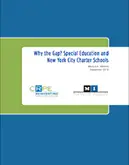Read the Executive Summary
This study uses NYC data to analyze the factors driving the gap in special education enrollment between charter and traditional public schools. Among the findings:
- Students with disabilities are less likely to apply to charter schools in kindergarten than are regular enrollment students. This is the primary driver of the gap in special education enrollments.
- The gap grows as students progress through elementary grades, largely because charter schools are less likely than district schools to place students in special education—and less likely to keep them there.
- The gap also grows as students transfer between charter and district schools. Between kindergarten and third grade, greater proportions of regular education students enter charter schools, compared to students with special needs.
- There is great mobility among special education students, whether they attend a charter or traditional public school. Close to a third of students in special education leave their school by the fourth year of attendance, whether they are enrolled in charters or traditional public schools.
Given the complex factors revealed by the study, the report cautions against simplistic policy solutions like quotas and enrollment targets. Instead, policy attention might be more usefully spent identifying and replicating effective academic or behavioral interventions that allow schools to declassify students with mild disabilities, and investigating why parents of students with special needs are not choosing charters early on.
The study uses data from the NYC Department of Education and 25 NYC charter elementary schools. CRPE is conducting research in other cities to find out whether the results from this study apply more broadly.
Citation: Marcus A. Winters, Why the Gap? Special Education and New York City Charter Schools (Seattle, WA: Center on Reinventing Public Education, September 2013).




